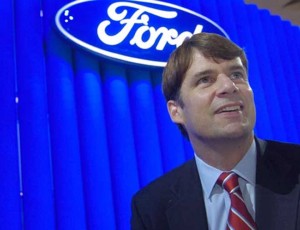It’s time to do some “myth-busting,” says Ford Motor Co.’s global marketing chief, and the maker is counting on a new global ad campaign, dubbed “Go Further,” to get its message out to potential customers who have long ignored the brand – whether in Boston, Berlin or Beijing.
Replacing the old “Drive One” effort, the unusual new campaign — which downplays the Ford name to lure consumers in for a closer look — will be the largest in the maker’s history, with spending “on a car launch level” even when promoting the overall brand, noted marketing czar Jim Farley during a Monday news conference.
The goal, added another Ford executive, is to use “every channel” available, from traditional print and television advertising to the latest in social media channels, to reach an otherwise over-saturated market.
And preliminary results suggest the Go Further campaign, launched late last month, is already paying off, generating tremendous follow-through by motorists along the import-oriented coasts. Ford spots on outlets like youtube.com have been watched or downloaded more than 3.4 million times, said the executive, on a par with what the best ads to run on the Super Bowl might normally generate.
“We have an opportunity to change (perceptions),” said Farley during a discussion of the Go Further campaign, “especially on the coasts,” where he stressed “perceptions lag reality.”
What’s particularly unusual about the Go Further campaign is Ford’s decision to downplay its familiar Blue Oval logo, Farley noting that it immediately triggers preconceived notions of the brand. Instead, the maker wants to take motorists by surprise.
“We needed to interrupt and surprise people,” said marketing communications director Matt Van Dyke. “And we found out that (the initial campaign) really did.” And it sent people rushing online for more information.
Ford has seen a significant improvement in its quality in recent years, he noted, and now rivals the best Japanese competitors, such as Toyota and Honda, in many studies. Meanwhile, Farley adds, it now offers some of the best fuel economy in segments where it competes, thanks to new technologies such as its turbocharged EcoBoost engines. The problem is that many parts of the market have not “caught up” yet.
The goal with Go Further is to bring perceptions in line with reality, especially on the fuel economy front. But Ford will touch on other interpretations of the Go Further theme as it emphasizes its readiness to deliver premium levels of technology at a mainstream price tag. Farley specifically noted the new inflatable rear seatbelts being offered on several Ford models, such as the new 2012 Explorer SUV.
The preliminary Go Further ads have been driving significant traffic to Ford websites. And that interest is touching on a wide range of new products, “not just the usual suspects,” the marketing chief suggested. While the Mustang is always a draw for consumers, even the C-Max, a so-called “people-mover” not yet in production, has been seeing a big surge in consumer interest.
With the preliminary success of Go Further, developed in a partnership between global ad agency WPP and Ford, the maker now intends to ramp up the campaign for the critical launch of the all-new Escape crossover-utility vehicle.
It will also be used for the introduction of Escape’s European twin, the Ford Kuga.
Over the next year or so, Ford will continue rolling the campaign out on a worldwide basis. Farley said the maker closely studied global brand campaigns used by companies such as McDonalds and Nike to see how they work. It clearly also looked back into its own history to see what can go wrong.
As part of the long-abandoned Ford 2000 reorganization the maker had attempted unsuccessfully to go to a global ad strategy. But back then, virtually everything was being run out of corporate headquarters in the Detroit suburb of Dearborn. There’ll be more regional autonomy to tailor ads for individual markets and there may be some that don’t adopt the Go Further theme if it doesn’t play well in the local language, Farley cautioned.
How much Ford will spend is unclear but it won’t be cheap. For one thing, Ford wants to remain a significant force in traditional TV and even print, but will sharply step up its game in alternative media, as well, according to WPP chief Martin Sorrell.
In the past, Farley has confirmed that a high-profile launch of an all-new product can run upwards of $100 million, with even a significant update of a less important model pushing to half that figure.
The Escape launch will be followed by the debut of the new Fusion sedan, a radically restyled midsize models that will be offered globally under several different nameplates. It will be followed by the C-Max “people-mover,” which Ford hopes can serve as its answer to the Toyota Prius. Though sold with a mix of powertrains, including gas and diesel, in Europe, the American C-Max will be offered only with a pair of battery-based drivelines in the States: a standard hybrid and a more advanced plug-in. It will serve as a centerpiece in the maker’s advanced powertrain strategy.
While Ford suffered a minor slide in sales last month, the maker noted that it consciously has chosen to cut back on low-profit fleet sales in order to emphasize higher-margin retail business.
It has the luxury to try that shift because its data suggests more consumers are giving the brand a closer look. Its “consideration” factor is up 32% compared to 2008 and it now has a larger share of potential buyers looking at its products than Honda – though Farley acknowledged it still lags behind Toyota – a target he intends to take on with the Go Further campaign.

